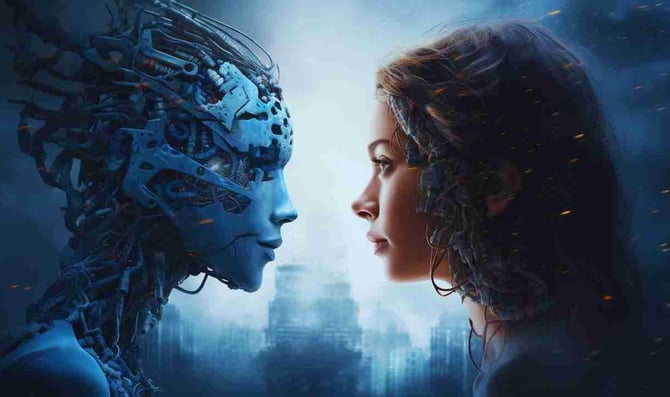OpenAI’s New Orion Model Faces Big Hurdles: What This Means for the Future of AI
OpenAI's upcoming Orion model faces obstacles in surpassing GPT-4, mainly due to data limitations and high computational costs. These challenges underscore the need for innovation in AI development that balances power, efficiency, and sustainability.
11/12/20243 min read


The world of artificial intelligence keeps moving fast, but OpenAI’s highly-anticipated next-gen model, code-named "Orion," has reportedly hit some serious bottlenecks on its journey to outdo its predecessor, GPT-4. Here’s what we know so far about Orion’s progress, its challenges, and why this matters for AI enthusiasts and the tech industry alike.
The Promise of Orion: Aiming to Surpass GPT-4
OpenAI has been a leader in pushing boundaries, with GPT-4 setting high standards in natural language processing. Orion was expected to take AI capabilities even further, particularly in coding and other specialized tasks. But as OpenAI has worked to scale the model, Orion has encountered obstacles that underscore the challenges in developing ever-larger and smarter AI systems.
Key Bottleneck: Limited High-Quality Data
One of Orion's biggest hurdles lies in data scarcity. Training a robust AI model requires massive amounts of high-quality, diverse data. For basic language tasks, general datasets can work well, but Orion’s developers are finding it increasingly difficult to gather the refined, specialized data needed to train the model for advanced tasks—especially in fields like programming.
Orion’s early performance has been impressive in handling general language prompts, but as it’s pushed to tackle highly specific requests, its capabilities fall short of initial expectations. In short, scaling up the model only goes so far without the right data behind it.
The Computational Cost Conundrum
Another issue? The skyrocketing costs of training and maintaining these colossal AI models. Each new generation of AI takes exponentially more computational power to train. This is expensive, not only in terms of resources but also in energy consumption, raising sustainability concerns.
For OpenAI, this means balancing between building a more advanced, capable model and managing the operational costs and environmental impact. The larger Orion becomes, the more difficult and costly it is to refine, test, and deploy effectively. This bottleneck might force OpenAI and other AI leaders to rethink how they approach future AI advancements, potentially pivoting to make AI improvements more sustainable.
Coding Challenges: Where Orion Falls Short
GPT-4 already has shown strong abilities in helping with coding tasks, but it still has limitations. OpenAI had high hopes that Orion would overcome some of these barriers, providing better accuracy, debugging abilities, and even original code generation. However, the specialized data required to enhance coding expertise is harder to find, especially for emerging languages or niche programming tasks.
The Orion model can generate code and understand programming concepts to a point, but reports indicate it’s not outperforming GPT-4 at a level that OpenAI hoped for. This means Orion may not make as big of a leap in coding support, potentially leaving room for improvement in future iterations.
What’s Next for Orion? Early 2025 and a Fresh Start
While Orion’s exact launch date hasn’t been confirmed, it’s likely to debut in early 2025. To differentiate Orion from previous models, OpenAI might also be looking to rebrand. Rather than using the GPT naming system, they’re considering a shift that could reflect the new capabilities and structure Orion brings.
For developers, companies, and enthusiasts waiting to see what’s next, the potential rebranding signals a step toward a new phase of OpenAI’s technology. While Orion’s initial goals may have shifted, its launch still represents a significant evolution in AI and machine learning.
The Broader Impact on the AI Industry
The challenges Orion faces are a microcosm of the larger questions within AI development. As these systems grow more complex, developers and researchers need to consider how to balance power with sustainability. The hurdles Orion encounters could spark innovation, leading to new techniques for building highly efficient models that require less data or lower computational costs.
For anyone in tech, this story highlights how quickly the landscape can shift. What worked a few years ago for training models may no longer be feasible today. AI companies are now pressed to not only innovate but also do so responsibly, with an eye on the environmental and economic costs.
Why It Matters for the Hustle-Minded Reader
As entrepreneurs and tech-savvy readers, it’s crucial to understand the underlying trends shaping AI. The hurdles facing Orion suggest that rapid growth isn’t always sustainable without recalibrating strategies and expectations. For anyone looking to leverage AI for business, the lesson here is to stay adaptable and be aware of the shifting possibilities and limitations in the AI landscape.
AI is an incredible tool, but as we see with Orion, it’s not a perfect, limitless solution. As AI developers work through these obstacles, we’ll likely see more breakthroughs aimed at making AI more accessible and practical, which means more opportunities for businesses of all sizes to incorporate AI in ways that were previously unimaginable.
Orion’s journey underscores the reality that advancing AI is as much about creativity and problem-solving as it is about raw data and computing power. While it may be a while before we see Orion reach its full potential, the model’s progress reminds us that every tech hurdle can also be a stepping stone. For now, the key takeaway is to keep watching this space and stay ready for the shifts AI evolution brings, both in terms of what’s possible and what’s practical.
Inspiration
Explore innovative business ideas and success stories.
Connect
Discover
hello@thehustlesunday.com
© 2024. All rights reserved.
Designed and Developed by Friday Pixels
